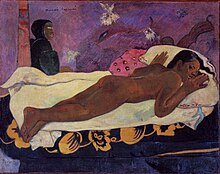The 1970s saw screen depictions of ghosts diverge into distinct genres of the romantic and horror. A common theme in the romantic genre from this period is the ghost as a benign guide or messenger, often with unfinished business, such as 1989's Field of Dreams, the 1990 film Ghost, and the 1993 comedy Heart and Souls.[88] In the horror genre, 1980's The Fog, and the A Nightmare on Elm Street series of films from the 1980s and 1990s are notable examples of the trend for the merging of ghost stories with scenes of physical violence.[81]
Popularised in such films as the 1984 comedy Ghostbusters, ghost hunting became a hobby for many who formed ghost hunting societies to explore reportedly haunted places. The ghost hunting theme has been featured in reality television series, such as Ghost Adventures, Ghost Hunters, Ghost Hunters International, Ghost Lab, Most Haunted and A Haunting. It is also represented in children's television by such programs as The Ghost Hunter and Ghost Trackers. Ghost hunting also gave rise to multiple guidebooks to haunted locations, and ghost hunting "how-to" manuals.
The 1990s saw a return to classic "gothic" ghosts, whose dangers were more psychological than physical. Examples of films from this period include 1999's The Sixth Sense, The Others, and HBO's 2001-2005 series Six Feet Under.
Asian cinema has also produced horror films about ghosts, such as the 1998 Japanese film Ringu (remade in the US as The Ring in 2002), and the Pang brothers' 2002 film The Eye.[89] Indian ghost movies are popular not just in India, but in the Middle East, Africa, South East Asia and other parts of the world. Some Indian ghost movies such as the comedy / horror film Chandramukhi have been commercial successes, dubbed into several languages.[90] Generally the movies are based on the experiences of modern people who are unexpectedly exposed to ghosts. They usually draw on traditional Indian literature or folklore, but in some cases are remakes of western movies, such as Anjaane, based on Alejandro Amenábar's ghost story The Others.[91]
In fictional television programming, ghosts have been explored in series such as Supernatural, Ghost Whisperer and Medium. In animated fictional television programming, ghosts have served as the central element in series such as Casper, Danny Phantom, and Scooby-Doo. Various other television shows have depicted ghosts as well.

